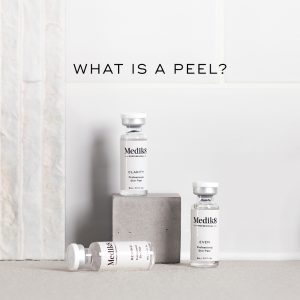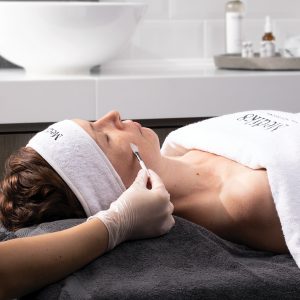News - January 18th 2022
Chemical peels can be gentler than you may think, they really are the ultimate anti-ageing treatment.....
What is a chemical peel?
A chemical peel is a treatment conducted on the skin. A solution is applied to an area with the intent to remove the upper layers. The skin does not have to actually ‘peel’ for it to be beneficial.

Although the word ‘chemical’ can seem quite seem quite scary it may be useful to know that chemical peels have been tried and tested for centuries. Humans have always searched for ways to exfoliate and brighten the skin. From the Greeks and the Romans making poultices using sulphur, mustard and limestone to the Turks who used fire as way to take off surface layers! The peel was really introduced in the late 19th century by an Austrian dermatologist called Ferdinand Ritter Von Hebra who used the ingredients of phenol, Croton oil, salicylic acid and resorcinol. Some of these ingredients you may have heard of and are used today in skin care treatments and products.
What are the benefits?
The protein in the upper layers of skin are broken down to renew the skin thus delivering a clearer brighter and younger looking skin. This treatment is great for anyone who has sun damaged skin, scarring, pigmentation, fine lines and wrinkles, acne, imperfections & imbalances on the skin.
Who can have a chemical peel?
Almost anyone can benefit from a chemical peel, even the most sensitive of skins!
Are there different types of peels?
Yes, and it can be very confusing when you are trying to decide which one is right for you. To simplify, there are three main different types of chemical peels. Very light, medium and deep. Every peel has a different strength, and each penetrates to various levels of the upper skin / epidermis.
 The light or superficial peels do not usually cause any flaking or redness to the skin and there is no down time needed. With this level of peel, it can be conducted every 2-4 weeks if recommended by your therapist. This type is for someone who has never had a peel before as it only works on the very surface of the skin.
The light or superficial peels do not usually cause any flaking or redness to the skin and there is no down time needed. With this level of peel, it can be conducted every 2-4 weeks if recommended by your therapist. This type is for someone who has never had a peel before as it only works on the very surface of the skin.
The medium strength peel goes to moderate depth and has a downtime of around three to 14 days. This type of peel can only be done if the skin type is suitable, has been fully prepared and the peel strength is slowly worked up to.
Lastly, deep peels reach the lower layer of the dermis (the reticular layer). This level of treatment is only conducted by a qualified doctor whilst under an aesthetic and is no longer very common. You would only be able to have this treatment done once in a lifetime.
At ‘The Edge’ we perform light – medium strength peels and only perform them after carrying out a thorough consultation. Before proceeding with this treatment, you will be given some home care products to fully prepare your skin at home. These products will be used for 2 weeks prior to your first treatment. Using these products prepares your skin properly and ensures you get the best results from your professional treatment.
We use MEDIK8 Products and peels which were created by the bio-chemist Elliot Isaacs. All are scientifically proven to target multiple skin concerns. This product range uses natural fruit acids and high-level active ingredients to ensure optimum and instant results.
Suitability
Not all treatments are for everyone and in certain circumstances some medications may need to be discontinued at least 5 days before a peel (such as Accutane) Further discussions may need to be had with your doctor before deciding on a peel. Some other reasons why you wouldn’t be able to have a peel include:
- Pregnancy or breastfeeding
- Recent cosmetic surgery
- Sunburn on area to treated
- Active Herpes Simplex
- Diabetes
- High blood pressure
- Deficient immune system
- open sores or legions
Other beauty treatments would also need to be timed to work around your peel, for example you will need to wait at least 2 weeks either side or waxing or threading.
Aftercare
- It is imperative that you use an SPF consistently after your peel (you should be using one every day anyway!). Do this regularly to protect your skin and allow it to heal thoroughly.
- Do not pick or pull your skin at any time after your peel, as it can cause scarring. Your skin may take anywhere from 3 to 14 days to completely peel depending on the strength of the peel or treatment you received.
- Do not exfoliate using a face scrub or any acid-based products for 2 weeks.
- Do not use any products that contain AHA, Glycolic, Retin-A, or any acne medication until your skin has finished peeling (usually 7 days, but possibly longer)
- Keep your skin well hydrated by drinking plenty of water and moisturising throughout the day with a good hydrating moisturiser (make sure you do this day and night.
- Avoid working out/ sweating for at least 24 hours and up to 48 hours after the treatment
If you want to find out more about how we can help you with your skin concerns and find out if a peel may be for you please contact us via social media, email or call the salon on 01453 844653